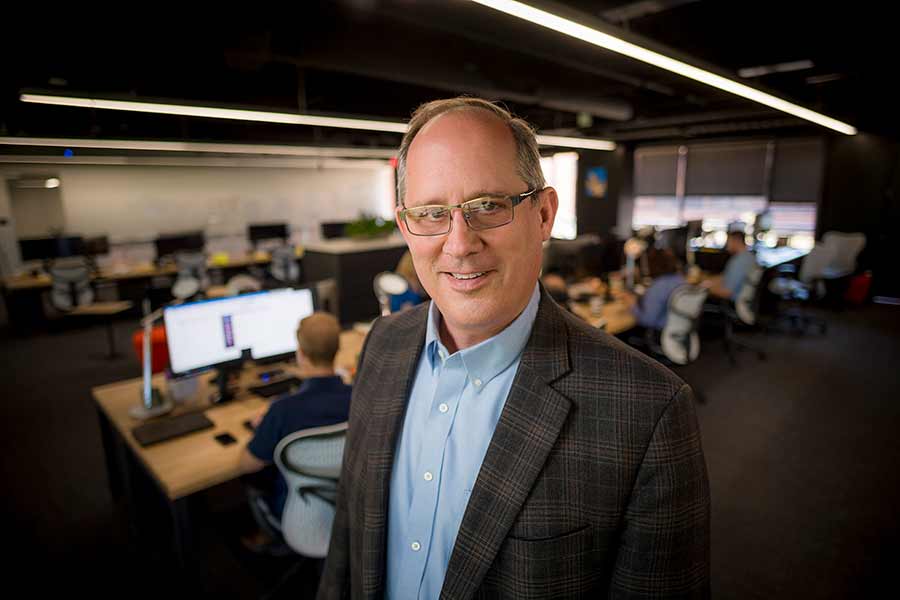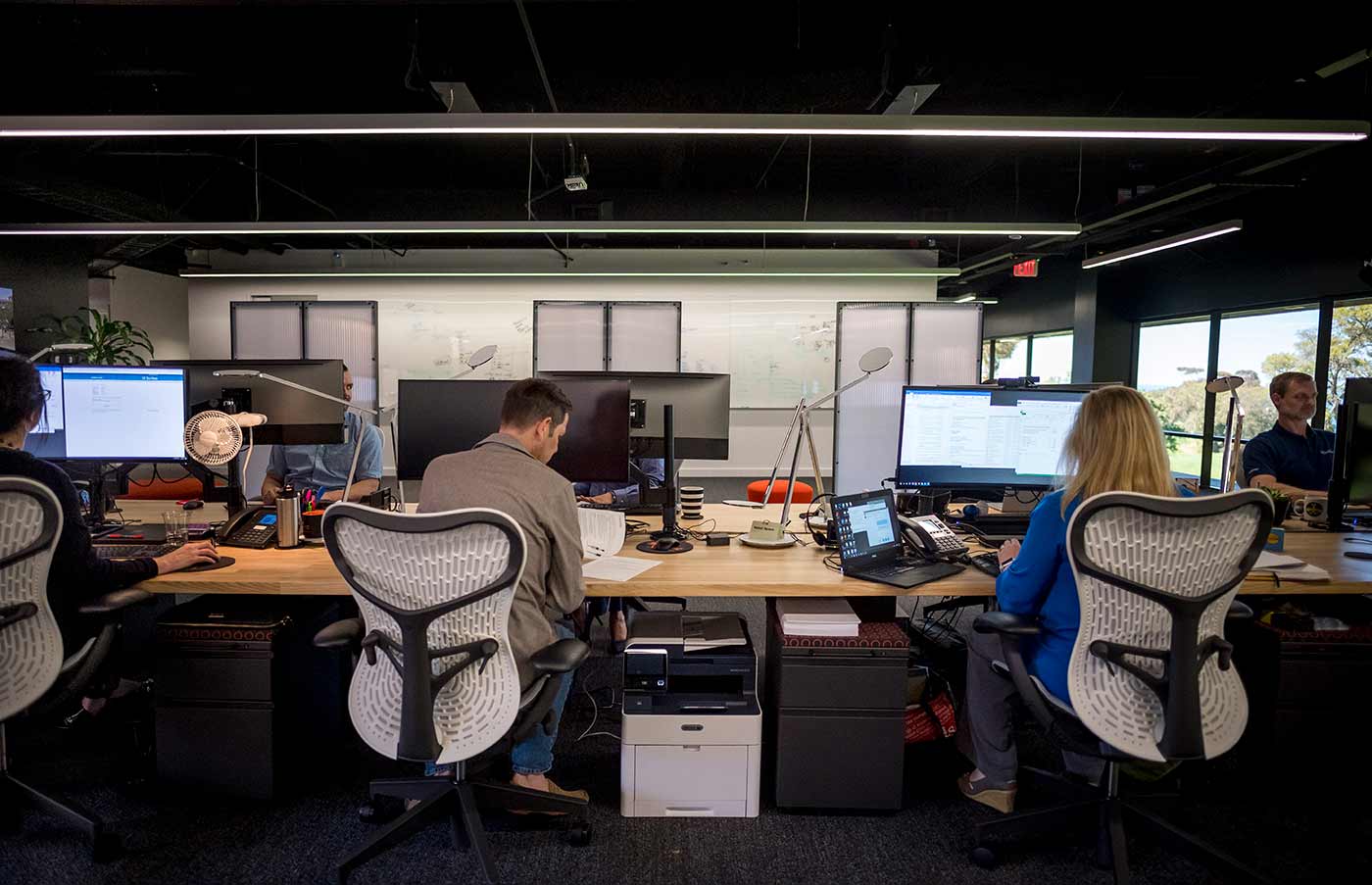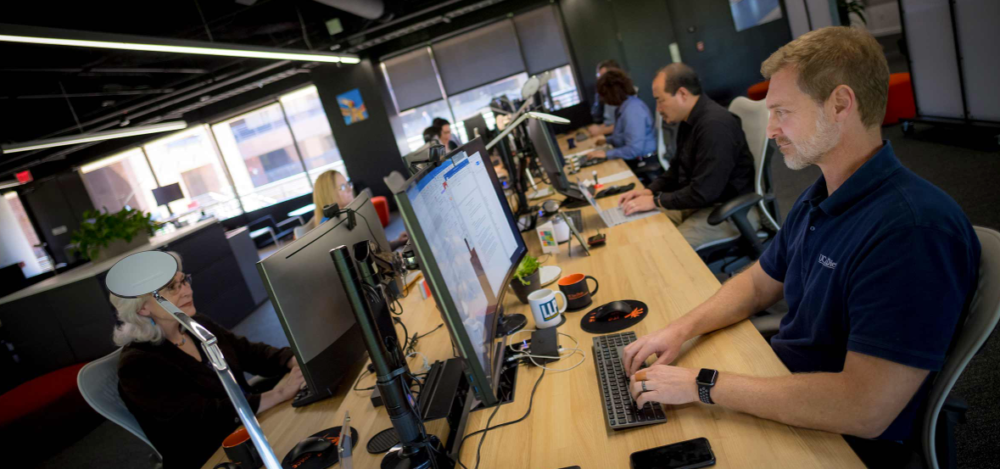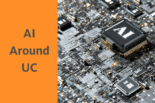When describing the ideal work environment, Vince Kellen, UC San Diego’s chief information officer, likes to use a sports illustration. He recounts the time when he sat next to an NHL recruiter at one of his son’s youth hockey games. Kellen asked the recruiter what he was looking for in the ideal player. Speed? Strength? Accuracy? None of those, said the recruiter.
“He told me, ‘I’m looking for the player who goes out on the ice and immediately makes his teammates better,'” said Kellen. “IT Services is a team sport. I want each of our staff members to inspire each other to do more.”
To support this team-focused philosophy, IT Services recently completed a total redesign and renovation of their offices, which are located in the Torrey Pines Center South across from the west end of campus. The floor was gutted, and open space was embraced – similar to the environment of Facebook, Google, Apple and other technology firms. Even without walls, it’s quiet, but the low buzz of activity and innovation is unmistakable.
Kellen and his leadership team worked with outside architects to design a space that mirrored the mission and needs of the department. “In IT, we are constantly learning and reinventing ourselves to keep up with technological advances,” said Kellen. “We wanted to create an environment that supports that learning, which often happens when groups are working together on projects.”
The primary workspace with employee desks and docking stations is completely open. The entire staff — including Kellen — sit together in the open space. When privacy is needed, employees can take advantage of 26 “think rooms,” which are also often used for small group brainstorming sessions. The space also boasts 12 conference rooms, including a “big meet” room for larger gatherings. The offices also feature informal collaborative spaces throughout the department for quick, on-the-fly meetings and discussions.

“Technology allows our employees to do their jobs anywhere, so we offer staff members the ability to decide, with their managers, what work arrangements are best for them,” said Kellen. “We want people to want to work here, and work/life balance is important. Overall, staff members accomplish more.”
Approximately 44 percent of staff have formal telecommute agreements, which range in the number of days worked remotely; many choose to telecommute 50 percent of the time. Some employees even live out of state and work remotely 100 percent of the time.
The new offices, which are designed with “hoteling” spaces, provide the tools necessary for those who only come into IT Services on occasion. The advantage?
“We are able to hire and consult with subject matter experts from around the nation, and even the world, to help us with special projects,” explained Brett Pollak, director of Workplace Technology Services in IT Services. “Another example is that a staff member on the East Coast is able to make updates to the Blink website on Eastern Standard Time, so that when the campus community arrives to work each day here on the West Coast, we already have fresh content populated on the website.”
 The entire staff, including department leadership sit together in the open space, which is also designed to support flexible working arrangements.Kellen suggests that supporting remote work can be more cost effective as well. “As a state university, we are constantly making efforts to work in more cost-effective ways, and in IT Services, management by wire allows us to do that,” said Kellen.
The entire staff, including department leadership sit together in the open space, which is also designed to support flexible working arrangements.Kellen suggests that supporting remote work can be more cost effective as well. “As a state university, we are constantly making efforts to work in more cost-effective ways, and in IT Services, management by wire allows us to do that,” said Kellen.IT Services has also implemented work management software, which helps keep remote workers connected and collaborative. It also supports the tracking of projects, including time spent by staff members on various initiatives. Kellen emphasizes that the productivity analysis is not intended purely for time tracking, but rather, it is designed to allow managers and employees to work together for improvement, and to inspire employees to consistently strive to achieve more.
“This software is a tool to reinforce the team,” said Kellen. “We can all see team gains and wins. It gets to the point where it’s hard to tell where your work ended, and the other team members’ began. And that, as a team, is very empowering.
This article originally appeared in thisweek@ucsandiego, March 21, 2019 and is re-posted with permission in the UC IT Blog.







